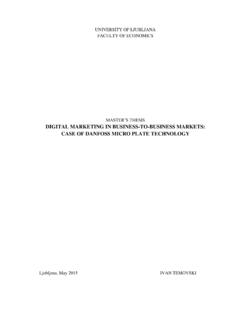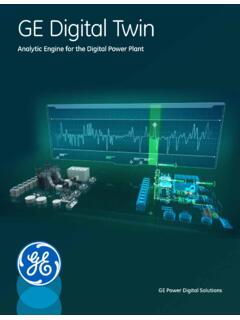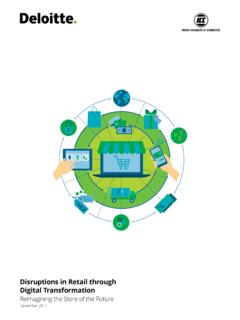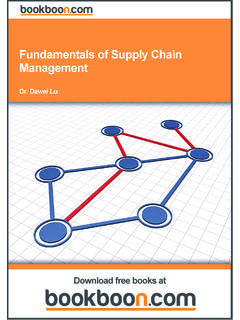Transcription of MASTER’S DEGREE THESIS Management of the Supply …
1 I LJUBLJANA UNIVERSITY FACULTY OF ECONOMICS master S DEGREE THESIS Management of the Supply Chain Case of Danfoss District Heating Business Area Ljubljana, February 2006 EVA KLEMEN I Author's STATEMENT I Eva Klemen i hereby certify to be the author of this master s THESIS that was written under the mentorship of Prof. Rudi Rozman and in compliance with the Act of Authors' and Related Rights Para. 1, Article 21. I herewith agree this THESIS to be published on the website pages of the Faculty of Economics. Ljubljana, Signature:..I LIST OF CONTENTS Page 1. INTRODUCTION 1 PROBLEM 1 PURPOSE AND GOALS OF THE THESIS 3 METHOD OF THE THESIS 4 STRUCTURE OF THE THESIS 5 2.
2 WHAT IS Supply CHAIN Management 6 DEFINITION OF Supply CHAIN 6 DEFINITION OF Management 8 DEFINITION OF Supply CHAIN Management 12 Supply Chain Management as a Management Philosophy 13 Supply Chain Management as a Set of Activities to Implement a Management Philosophy 13 Supply Chain Management as a Set of Management Processes 14 Supply Chain Management versus Supply Chain Orientation 17 Supply Chain Management versus Logistic 18 DRIVERS OF Supply CHAIN DEVELOPMENT AND MAIN INITIATIVES 20 DIFFERENT INITIATIVES AND LEVELS OF Supply CHAIN MATURITY 22 LEVELS OF Supply CHAIN MATURITY AND BUSINESS RESULT 24 3. KEY COMPONENTS OF SUCCESSFUL Supply CHAIN Management 25 Supply CHAIN AS A STRATEGIC ASSET 26 Supply Chain Strategy Building Blocks 27 Key Criteria for a Good Strategy 28 KEY Supply CHAIN PROCESSES 31 DESIGN OF Supply CHAIN ORGANISATION 33 DEVELOPMENT OF A COLLABORATIVE MODEL 35 Definition of Collaboration 35 Key Areas with Increasing Need for Collaboration 37 DESIGN OF MEASUREMENT SYSTEMS AND MEASUREMENTS 38 MOST COMMON BENEFITS, BARRIERS AND BRIDGES TO SUCCESSFUL Supply CHAIN Management 42 4.
3 INTRODUCTION OF DANFOSS DISTRICT HEATING BUSINESS AREA 44 INTRODUCTION OF DANFOSS GROUP 44 INTRODUCTION OF DISTRICT HEATING BUSINESS AREA 45 DHBA Business Development 45 Products and Markets 47 Organization 49 Vision 51 DH Supply CHAIN AND SCOPE OF FURTHER ANALYSIS 52 5. ANALYSIS OF DANFOSS DHBA Supply CHAIN Management 53 WHY DHBA IS FOCUSING ON Supply CHAIN Management 53 DH Supply CHAIN VISION AND STRATEGIES 54 Customer Service Strategy 55 Manufacturing Strategy 57 Outsourcing Strategy 59 Purchasing Strategy 60 Infrastructure 61 PROCESSES AND COLLABORATION MODEL 63 Management AND ORGANISATION 65 BALANCED METRICS 71 DHBA Supply CHAIN STRATEGY IMPLEMENTATION 72 Plateau B: Integrated Supply Chain 73 Plateau C: Merge with Danfoss IWK Supply Chain 74 Plateau D: Euro-land / Synchronized Supply Chain 75 6.
4 ANALYSIS OF CURRENT PERFORMANCE 76 TIME PERSPECTIVE 76 COST PERSPECTIVE 77 SERVICE PERSPECTIVE 79 QUALITY PERSPECTIVE 80 BENCHMARKING Supply CHAIN PERFORMANCE 82 7. STRENGTHS AND WEAKNESSES OF CURRENT Supply CHAIN Management AND INITIATIVES FOR THE FUTURE 83 STRATEGIC ORIENTATION 84 PROCESSES AND IT SUPPORT 86 Management AND ORGANISATION 87 COLLABORATION MODEL 88 MEASUREMENT SYSTEM 89 KEY INITIATIVES FOR THE FUTURE 91 8. CONCLUSION 93 LITERATURE 97 SOURCES 99 APPENDIX i POVZETEK I LIST OF TABLES Page Table 2-1: Relations between Management , Business, and Organizational Processes 9 Table 2-2: Management Processes, Purpose, Tasks, and Skills 10 Table 2-3: Distinct Management Processes 16 Table 2-4: Comparison of Supply Chain Management Frameworks (GSCF, SCOR) 16 Table 3-1: Supply Chain Contribution to Business Strategy 29 Table 5-1: Customer Offerings 56 Table 7-1: Strengths and Weaknesses of DHBA Supply Chain Strategy Main Building Blocks 84 Table 7-2: Strengths and Weaknesses of DHBA Supply Chain Strategy by Main Criteria s 85 Table 7-3: Strengths and Weaknesses per Key Processes in DHBA Supply Chain 86 Table 7-4.
5 Strengths and Weaknesses: Management and Organization 87 Table 7-5: Strengths and Weaknesses by Areas: Between Processes within Operations, with Other Functions, with Internal/External Suppliers, Customers and Other Partners 88 Table 7-6: Strengths and Weaknesses of Measurement System 90 Table 7-7: Key Focus Areas for the Future Supply Chain Improvements 92 LIST OF FIGURES Page Figure 2-1: Competitive Framework in the Supply Chain 7 Figure 2-2: Supply Chain or Supply Chain Network 8 Figure 2-3: Supply Chain Management Reasons and Consequences 17 Figure 2-4: Perspectives of SCM versus Logistic 18 Figure 2-5: Generic Value Chain 19 Figure 2-6: The Value System 20 Figure 2-7: A Decade of Supply Chain Initiatives 21 Figure 2-8: Levels of Supply Chain Maturity 23 Figure 3-1: Five Core Disciplines for Strategic Supply Chain Management 26 Figure 3-2: Types of Manufacturing Strategy 27 Figure 3-3: Market Winners Market Qualifiers Matrix for Agile versus Lean Supply Chain 29 Figure 3-4: Matching Supply Chain with Products 30 Figure 3-5: Supply Chain Practices and Basis of Competition 32 Figure 3-6: New Roles for End-to-End Supply Chain Management 35 Figure 3-7: Supply Chain Collaboration Areas with Highest Potential 37 Figure 3-8: Biggest Problems in Supply Chain that Impact Shareholder Value 38 Figure 3-9: Supply Chain Metrics 39 Figure 3-10.
6 From Supply Chain Decision through Capabilities to Financial Results 40 Figure 3-11: Definition of EVA, RONA 41 Figure 3-12: Top Ten Benefits, Barriers, and Bridges to Supply Chain Management 43 Figure 4-1: Danfoss Divisions 45 Figure 4-2: DHBA Turnover Growth in Million DKK 46 Figure 4-3: DHBA Main Milestones 46 Figure 4-4: Two Main Types of Product Offerings 47 Figure 4-5: Share of Turnover per Product Types in 2004 47 Figure 4-6: Main Product Applications 48 Figure 4-7: Share of Turnover per Customer Type in 2004 48 Figure 4-8: Share of Turnover per Regions 49 Figure 4-9: Organization of DHBA 49 Figure 4-10: DH Operations Organization in 2005 50 Figure 4-11: Level of Integration in DH Supply Chain 52 Figure 5-1: Concept of Order and Customer Relations Management 56 Figure 5-2: Make to Order Manufacturing Strategy 57 Figure 5-3: Manufacturing Concept of Decupling Points 58 Figure 5-4: Daily Planning Concept 58 Figure 5-5: XYZ Concept for Daily Balancing of Capacities 59 Figure 5-6: Outsourcing Concept 60 Figure 5-7: Portfolio Matrix of Suppliers and Materials 61 Figure 5-8: Integrated Supply Chain Model: Process and Collaboration Aspect 64 Figure 5-9: Core DH Supply Chain Processes Divided in Sub-Processes 65 Figure 5-10: Management and Organization Model 66 Figure 5-11: Total Order Management Concept 67 Figure 5-12: Supply Chain Planning Concept Different Levels of Planning 67 Figure 5-13.
7 Supply Chain Planning in Time Perspective 68 Figure 5-14: Concept of Availability Management 69 Figure 5-15: Balanced Scorecard 71 Figure 5-16: DHBA Supply Chain Vision and Development Path 72 Figure 5-17: Objectives of Plateau B 74 Figure 6-1: Logistic Costs as Percentage of Turnover (Total Net Sales) 77 Figure 6-2: Stock Costs as Percentage of Turnover (Total Net Sales) 78 Figure 6-3: Service Level Measurements: Availability and Reliability for CDC from 2000 to 2005 79 Figure 6-4: Service Level Measurement from Production (SIDH) to CDC and from Suppliers to SIDH 80 Figure 6-5: Benchmarking DHBA Supply Chain Performance 82 Figure 6-6: Maturity Level of Supply Chain Processes 83 Figure A-1: Types of Products i Figure A-2: Physically Efficient versus Market Responsive Supply Chain i Figure A-3: Example of RACI Structure for Procurement ii Figure A-4: Objectives per Critical Success Factor for DH Operations ii LIST OF ABBREVIATIONS: APS: Advanced Planning and Scheduling BTS: Built to-Site CDC: Central Distribution Centre COGS: Cost of Goods Sold CPFR: Collaborative Planning, Forecasting & Replenishment CRM: Customer Relations Management DH: District Heating DHBA: District Heating Business Area DHW: District Heating Works DKDHH: Danfoss Nordborg Headquarters DSC: Danfoss Sales Company EDI: Electronic Data Interchange ERP: Enterprise Resource Planning GSCF: Global Supply Chain Forum HVAC.
8 Heating, Ventilation, and Air-Conditioning IT: Information Technology JSA: Joint Service Agreements KPI: Key Performance Indicators MRP II: Materials Requirements Planning OEM: Original Equipment Manufacturer PLM: Product Lifecycle Management RACI: Responsible, Accountable, Consulted, and Informed RONA: Return on Net Assets SCOR: Supply Chain Operation Reference model SAP: Enterprise Resource Planning System used in Danfoss SC: Supply Chain SCM: Supply Chain Management TNS: Total Net Sales TQM: Total Quality Management VMI: Vendor Managed Inventory 1 1. INTRODUCTION PROBLEM Over the past decade, there has been an increasing emphasis on Supply chain Management as a vehicle through which firms can achieve competitive advantage in markets (Collin, 2003, p.)
9 8). A large number of examples in the 1990s show how companies have made large investments to streamline their Supply chains in order to improve customer satisfaction and increase their internal productivity. As Christopher (1998, ) states, it is not actually individual companies that compete with each other nowadays; rather, the competition is between rival Supply chains. The Supply chains that add the most value for customers with the lowest cost in the chain make up the winning network of individual companies. As companies are now seeking how to integrate decisions across Supply chain functions, across geographically dispersed facilities, and across time, the facts based Supply chain Management is crucial.
10 The essence of fact-based Supply chain Management is integrated planning and control, which has three important dimensions. The first dimension is functional integration involving decisions about purchasing, manufacturing, and distribution activities within the company and between the company and its suppliers and customers. The second dimension is geographical integration of these functions across physical facilities located on one or several continents. The third dimension is inter-temporal integration of strategic, tactical, and operational Supply chain decisions. To put it simply, strategic planning and control are concerned with resource acquisition, while tactical planning and control focus on resource allocation and refinement, and operational planning and control are concerned with business execution (Shapiro, 2001, p.)










